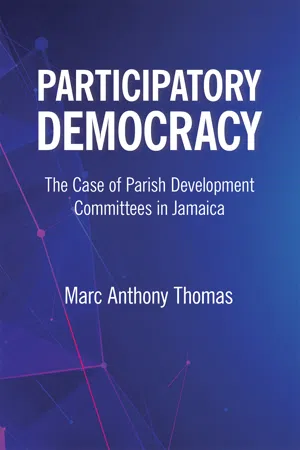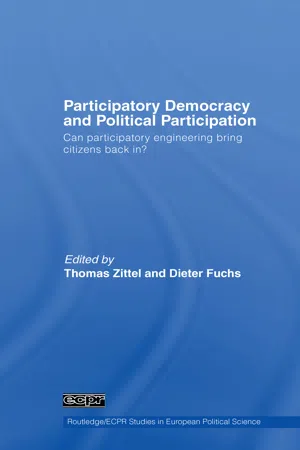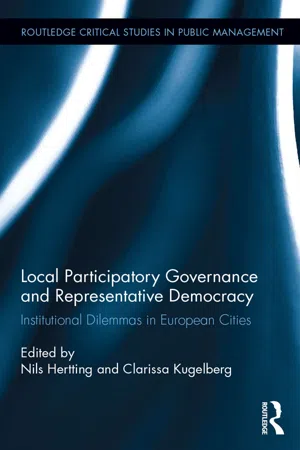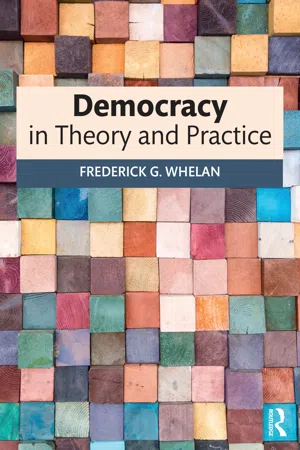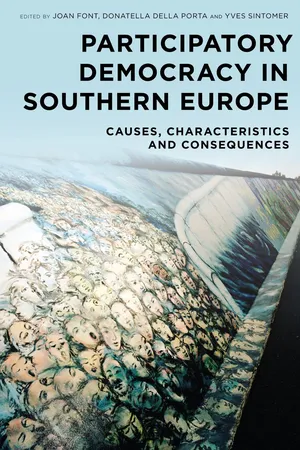Politics & International Relations
Participatory Democracy
Participatory democracy is a system in which citizens actively participate in decision-making processes, often through direct involvement in policy formulation and implementation. This approach emphasizes the importance of inclusive and transparent governance, allowing individuals to have a direct impact on political outcomes. It aims to empower citizens and promote a more equitable distribution of power within society.
Written by Perlego with AI-assistance
Related key terms
Related key terms
1 of 4
Related key terms
1 of 3
12 Key excerpts on "Participatory Democracy"
- eBook - ePub
- Fabio de Nardis(Author)
- 2020(Publication Date)
- Palgrave Macmillan(Publisher)
equality . The inevitable oligarchic degeneration of representative democracies is disputed, claiming a classical conception of popular sovereignty exercised through broad, inclusive participation according to the aspirations of the first democratic movements that have developed in Europe since the end of the seventeenth century.The supporters of Participatory Democracy consider the involvement of citizens to be fundamental regardless of the casting of a vote (Arnstein 1969 ; Pateman 1970 ; Barber 2004 ). As Pateman points out, citizens should be guaranteed as many spaces of action as the spheres of political decision-making are, in a context of full participation, understood as the process in which each individual member of a decision-making body has equal power to determine the outcome of decisions (Pateman 1970 , 70–71). As Arnstein points out, citizen participation is a category of citizen power that must be guaranteed free access to the information needed for decision-making, without necessarily relying on their passivity in favour of political professionals (Arnstein 1969 , 216). Political participation thus conceived assumes a function of socialisation to the values and institutions of a democracy, conceived as a collective action for the common good. Participation as a “school of democracy” produces stimuli for social activism and mutual trust (Barber 2004 , 152). The dimension of civic education emerges in research on social movement activists who, in the course of action, show that they transform themselves by feeding on democratic virtues that draw their lifeblood from participatory action (Szas 1995 , 154; Patenan 1970 , 42–43).At the same time, democratic participation becomes the tool of the popular classes for the redistribution of resources and values in society. Participatory Democracy is also and above all a social conception of politics based on the need for a free expression of conflicts in the collective practice for equality . In this sense, it presents numerous elements in common with the concepts of “associative democracy” (Hirst 1994 ) and “radical democracy” (Laclau and Mouffe 2001 ), which emphasise the practices of social self-organisation even in substitution of some state functions, emphasising the need for competitive democracy as a peaceful way of managing conflicts between opposing interests (Mouffe 2005 - eBook - ePub
- Magdalena Góra, Cathrine Holst, Marta Warat(Authors)
- 2017(Publication Date)
- Routledge(Publisher)
Jenny Pearce (2010b) defines the participatory shift as a process of creating spaces for experimenting with the alternative forms of civic involvement in politics, governance and decision-making processes. Participatory Democracy is based on the idea of consensus-based decision-making processes (Aragonès and Sánchez-Pagés 2008). In his article about the roots of Participatory Democracy, Antonio Floridia (2013: 4) points out its three theoretical components. The first concerns the assumption that every human being is competent enough to govern his or her own life and has the ability to deal with the problems affecting him/her. Second, everyone has the right to self-determination and personal freedom but, at the same time, is community-oriented and willing to act for the common wealth. The last component is the idea that decision-making processes concerning issues with social implications and consequences must be conducted in public and participative ways. He further underlines that Participatory Democracy may become a response to crises of representative democracy, as it calls for a local and communitarian view of democracy, promoting bottom-up policymaking processes and empowerment of all social groups. Participatory Democracy can be a space for practising the right to self-determination, especially for groups and communities that are excluded from the traditional political sphere. This way of arguing is based on the assumption that these communities are driven more by communal interests than individual ones.(…) Participatory Democracy was considered the tool through which a new, critical and antagonistic, subjectivity could be built. Thus, the idea of the empowerment of local societies returned to the foreground; as did the idea that local communities are capable of ruling themselves with “direct” forms of democracy.(Floridia 2013: 6)The concept of Participatory Democracy also has its weaknesses. Even though the aim of this chapter is to analyse a particular tool – participatory budgeting – it is crucial to underline that the idea of equal access to the participatory process and its transparency clash with the structure of power (also on the local level) and mechanisms of exclusion of marginalised groups. As Lynn M. Sanders (1997: 2) notes, the idea of participatory decision-making processes is very utopian, as many citizens do not even have access to these participatory spaces. The structural mechanisms of discrimination may limit full participation of certain groups because of factors such as gender, race, ethnicity, disability etc. It is important to take this dynamic into consideration while analysing the methods of Participatory Democracy. Besides presenting the normative aspect of Participatory Democracy, the focal point of this chapter is to examine a more practical dimension of this political idea. Archon Fung and Erik Olin Wright (2001) propose an analytical model called Empowered Deliberative Democracy, which has been used to analyse political strategies rooted in Participatory Democracy at a local level. There are three principles of this model: practical orientation, bottom-up participation and deliberative solution generation (Fung and Wright 2001). Practical orientation means changing the perspective of actions from abstract and systemic to particular problems. An example would be creating local policies responding to the needs of communities, such as access to public services like housing or education. The idea of bottom-up participation is explained as a way to “establish new channels for those most directly affected by targeted problems – typically ordinary citizens and officials in the field – to apply their knowledge, intelligence, and interest to the formulation of solutions” (Fung and Wright 2001: 18). The last principle – deliberative solution generation – refers to the way the community reaches a final decision. The process is based on discussions and arguing what aims to solve problems, design policy or form a strategy. The crucial element of deliberating is that the interests of the community take priority over the interests of individuals. These three principles proposed by Fung and Wright are reflected in the method of participatory budgeting. In this chapter, this model is not used to assess the participatory budgeting, but to outline the theoretical and normative framework of this tool. The empirical section is focused more on the impact that it has on the local communities. - eBook - ePub
Can Democracy Be Saved?
Participation, Deliberation and Social Movements
- Donatella della Porta(Author)
- 2013(Publication Date)
- Polity(Publisher)
associational democracy (Hirst 1994), which focuses upon the need for citizens to self-organize. Associational experiences in civil society are here considered not only to be capable of replacing the state in some of its functions, but also to produce social solidarity, contributing to the democratic socialization of the citizens as well as to the production of social goods.Participation should thus be an instrument for redistributing resources to the advantage of the weakest. While interest groups favour the most resourceful through less visible lobbying, these arenas of participation should give more power to the powerless. For Peter Bachrach, democratic participation is ‘a process in which persons formulate, discuss, and decide public issues that are important to them and directly affect their lives. It is a process that is more or less continuous, conducted on a face-to-face basis in which participants have roughly an equal say in all stages, from formulation of issues to the determination of policies’ (1975, 41). The participation of those who are excluded is an instrument for reducing inequalities as a democratic public sphere should provide the mechanisms for recognition and representation of the voices and perspectives of those who are oppressed (Young 1990, 184). From this point of view, the participatory approach tends to stress also the substantive, social dimension of democracy (Schmidt 2010, 225–35).Conflicts are central in the conceptions of radical democracy (Laclau and Mouffe 2001), which presents agonist democratic politics as a peaceful way to manage conflictual interests that emerge in the (antagonist) political - eBook - ePub
- Stephen Harrison, Ruth McDonald(Authors)
- 2007(Publication Date)
- SAGE Publications Ltd(Publisher)
Chapter 5The Politics of Democracy and Participation
Summary of chapter contents- Public and user participation: key concepts
- Public and user participation: history and contemporary developments
- Interpreting public and user participation
Public and user ‘involvement’ refers to participation in some aspect of the governance, design or availability of public services, that is as something more than simply using the service. It relates both to contemporary debates about appropriate governance for specific services such as the NHS and to broader debates about democracy and citizenship in the UK. The latter can perhaps be summarised as manifesting a growing interest in ‘participatory’ democracy, that is treating public policy as the occasion for public education ‘in the widest sense, including both the psychological aspect and gaining of practice in democratic skills and procedures’ (Pateman, 1970: 42). One strand of this debate presents participation as the remedy for a so-called ‘democratic deficit’, as a supplement to the perceived inadequacy of representative democracy, especially in local government: low electoral turnouts, a focus on service provision rather than local voice, poor representation resulting from the ‘first past the post’ electoral system, and the assumption that the fact of election guarantees representativeness (Stewart, 1997). The view has acquired further credence in a UK context where representative government has been partially replaced over the last 30 years by what has been variously termed the ‘new magistracy’ (Stewart and Davis, 1994) or the ‘appointed state’ (Skelcher, 1998), that is the proliferation of public institutions with appointed, rather than elected, governing bodies.A second strand of current interest in Participatory Democracy views the process of participation as an end in itself; so-called ‘active citizenship’ entails ‘a concept of both being and of doing’ (Prior et al., 1995: 2). It may therefore be valued as an antidote to social fragmentation (Gyford, 1991: 33; see also Pateman, 1970: 22) especially that brought about by the loss of community in areas whose economic existence has depended on now declining industries. A third strand of interest sees participation as part of both neo-liberal critiques of Marshall’s (1950) concepts of social rights and social citizenship (and hence of the welfare state) and as a potential response to such critiques (Faulks, 1998; Hayek, 1988; Rees, 1995; Plant, 1992). Increased political participation offers three rather different responses to such critiques. It offers a potential basis for self-help as opposed to passive reliance on state services. In addition, public participation in decisions about the rationing of welfare services would undermine a key neo-liberal argument: that welfare rights cannot be properly or non-arbitrarily enforced because of resource constraints. Finally, participation offers the possibility of political mobilisation in defence of social citizenship; historically, expansions in the definition of citizenship and of the rights consequent upon such definitions have only been obtained through extensive struggle (Giddens, 1982: 171). - eBook - ePub
Participatory Democracy
The Case of Parish Development Committees in Jamaica
- Marc Anthony Thomas(Author)
- 2021(Publication Date)
- The University of the West Indies Press(Publisher)
27 Such is possible because of the practices that sustain participatory governance processes to which the Jamaican model also subscribes. Understanding these methods and their limitations is therefore crucial to understanding how participatory governance may be operationalized.The Processes of Participation
The participatory model suggests that individuals and groups composed of residents from various backgrounds and interests can form a community through dialogue, but this does not always occur. Negotiation among private interests may, as James Madison suggested, produce the public good, but what often happens instead is the “fallacy of composition”. In such cases, the sum of negotiated private interests does not produce a suitable public outcome.28 Something more is needed than the aggregation of private claims for citizens to think and act publicly. Barber’s concept of “democratic talk” or speech addresses this concern. Barber argued that a citizenry begins to think and act publicly through dialogue when the members express their shared history and experiences. Democratic talk asks collective questions such as these: What shall we do? How does our society resolve its differences? The community’s experiential knowledge then provides the answers. This understanding can be moulded and applied as needed to act in the interest of the common good. Such knowledge is not fixed and is subject to change during the process of deliberation, reflecting the openness and flexibility needed for self-governance.29 Speech, under the participatory umbrella, stresses listening and active efforts to grasp other viewpoints; participationists know that they must explain their choices in a public language and are therefore constantly open to reflection. This process encourages those engaged in it to become more actively empathetic and open to bridging differences in order to further the interests of their broader community.30 Mutz argued similarly that the more “talk” occurs among different groups, the greater the likelihood that enmities will break down, friendships will develop and each will become more tolerant of the other’s views.31 The aim of such dialogue is not conformity, but an acceptance and awareness of others’ values.32 - eBook - ePub
Participatory Democracy and Political Participation
Can Participatory Engineering Bring Citizens Back In?
- Thomas Zittel, Dieter Fuchs(Authors)
- 2006(Publication Date)
- Routledge(Publisher)
The system of government that has since been known as democracy came into being in antique Athens. For the first and only time in history, literal self-government by the people was realized. The notion of a democratic system of government was taken up again in the modern age. Under changed societal conditions, it was implemented not as direct democracy but as liberal, i.e. representative democracy. However, political thinking developed that upheld the ideal of self-government by the people, and confronted existing liberal democracy with this ideal. But the onus of proving how this ideal could be realized has always been on the theory of so-called Participatory Democracy. The alternative would be for it to remain an interesting but merely cerebral pursuit.The versions of Participatory Democracy we have discussed stress deliberative forms of procedure and participation, and are accordingly referred to as theory of deliberative democracy. They assume that deliberative democracy is not only normatively desirable in modern society but also necessary to solve the practical problems of liberal democracy. If it is to do so, however, it must be possible in real terms. And to establish this, answers are needed to the questions of institutionalization and motivation. In our view, they have yet to be given, and can perhaps not be given at all. The structural restrictions of modern societies are presumably so strong that the ideal of Participatory Democracy cannot be realized even approximately.The only really concrete proposal for institutionalizing direct participation by citizens in the making of generally binding decisions has been advanced by Barber (1984), who advocates the instrument of the referendum at the national level. But there is a fundamental mismatch between the quantity of decisions that have to be made in the politico-administrative system and the quantity of referendums that can be held. This state of affairs is exacerbated by coupling referendums to prior discussions or deliberations, indispensable for the theory of Participatory Democracy. In this regard, Barber (1984: XIV) adjusts to reality in describing his strong democracy as a form of government “in which all of the people govern themselves in at least some public matters at least some of the time.” The number of decisions in which all citizens can participate directly, is, however, likely to be so small in relation to the total number of decisions to be made that this has almost nothing more to do with the normative postulate of self-government. - eBook - ePub
Citizens' Power in Latin America
Theory and Practice
- Pascal Lupien(Author)
- 2018(Publication Date)
- SUNY Press(Publisher)
This book answers these questions by examining participatory mechanisms in three countries through the eyes of the women and men who devote their time and energy to improving their communities. Why are these participatory innovations important? Liberal democracy is facing a crisis of legitimacy around the world, and particularly in Latin America. According to the 2015 Latinobarometer report, only 39% of Latin Americans were satisfied with the quality of democracy in their country. Perhaps even more troublesome is the low level of support for democracy in Latin America, with nearly half of the region’s citizens claiming that democracy is not necessarily the best form of government. Political institutions are failing to meet the aspirations of increasing numbers of citizens. The high level of public dissatisfaction with the current state of democracy has reignited the debate surrounding the most effective means of integrating popular participation into the policy process. Politicians, non-governmental organizations (NGOs), students of democracy and concerned citizens are thinking about innovative ways of deepening democracy. In order to engage in this discussion, we must develop a better understanding of the strengths and weaknesses of participatory mechanisms.This book contributes to this important discussion by looking at a particular type of participatory innovation that has emerged across Latin America: local citizens’ councils that provide individuals with the opportunity to engage in the decision-making process at the neighborhood level in an institutionalized environment. It compares participatory mechanisms in three countries with different models of participatory design: Venezuela’s radical Participatory Democracy, which claims to replace liberal representative institutions with grassroots direct democracy at the local level; Chile’s pragmatic efforts at expanding participation for the purposes of achieving more efficient governance and enhancing liberal institutions; and Ecuador’s hybrid model that demonstrates features of both.The following chapters enhance our knowledge on citizen participation in several ways. This is one of the first studies to examine participatory mechanisms from both a cross-country and within-country perspective. Most research has focused on either unique case studies or on within-country comparisons. It is the first to study the new “radical” participatory mechanisms in countries such as Venezuela and Ecuador in comparative perspective and to contrast these with different, more “pragmatic” models of participatory design. It also draws on original qualitative evidence and connects the readers to citizens who participate in these institutions. The book takes the reader into the heart of neighborhoods where marginalized citizens are attempting to use these institutions to improve their communities and have a voice in decisions that affect their lives. We will meet citizen participants from across these three countries, learn about the successes and failures they have experienced through their participatory processes, and hear about their hopes and frustrations. - eBook - ePub
Local Participatory Governance and Representative Democracy
Institutional Dilemmas in European Cities
- Nils Hertting, Clarissa Kugelberg, Nils Hertting, Clarissa Kugelberg(Authors)
- 2017(Publication Date)
- Routledge(Publisher)
For them it suggests that the democratic system is still dominated by privileged groups with regard to input to the political machinery and lost opportunity to better use the information and resources in the local community for improved problem-solving capacity during the output phases of the policy process. According to others, however, the conclusion is rather that the parliamentary chain of representative democracy and its institutional mechanisms to secure transparency and political equality are not being threatened or challenged (cf. Christiansen and Togeby 2006). Hence, in order to provide overview, we can cross the two dimensions established and desired participatory governance to arrive at four positions on participatory governance (cf. Figure 1.1 below). Affirmers and reformers share the view that there is a need for new and more participatory and interactive modes of governance. To be more specific, this argument comes in two different versions: the democratic revitalization rationale and the administrative effectiveness rationale. The democratic revitalization rationale begins with a more or less explicitly stated idea about a “democratic deficit” (Dalton, Scarrow and Cain 2004; Somerville 2011; Warren 2009) and increasing gaps between citizens, elected politicians, and civil servants. From such a perspective, participatory governance includes “democratic innovations” (Smith 2009) driven by attempts to “renew,” “deepen” (Fung and Olin Wright 2001), or “invest in” (Sirianni 2009) democracy in order to better safeguard democratic core values such as political equality, deliberation, and democratic accountability. In a European context, the most radical version of the democratic rationalization rationale is perhaps only relevant for counterfactual propositions and arguments. According to this position, participatory reform is more than a repair kit for representative democracy - eBook - ePub
- Frederick G. Whelan(Author)
- 2018(Publication Date)
- Routledge(Publisher)
It has been suggested that Americans’ involvement in associational activity has recently been declining, which might indicate significant erosion of political participation and of the civic culture that has supported US democracy. Others have argued, however, that declining numbers may primarily afflict traditionally prominent groups (especially labor unions, denominational churches, and large fraternal and social service organizations) that may be in the process of being replaced by other kinds of organizations, especially ones that serve more specialized constituencies by utilizing direct-mail and electronic-communication technologies. Traditional pressure groups have also been supplemented by social movements, a term that encompasses the more diffuse efforts of activists in an area of common concern, such as the feminist, gay-rights, and environmental movements. Although such movements typically have political agendas and policy goals, their main function is to mobilize mass support for the better organized and more professional pressure groups that share their objectives. The idea of Participatory Democracy is compatible with the evolution of new forms and technologies of civic activity.Observers have also noted an apparent proliferation of pressure-group activity in US political arenas. This includes business- or industry-based interest groups, but from a participatory standpoint the more important phenomenon is the flourishing of citizen-based, mass-membership advocacy groups devoted to a particular “values” or public-interest issue. Like parties, such groups attempt to mobilize voters to support candidates who favor their cause; and like interest groups, they attempt to influence the legislative process by lobbying representatives. Often these groups consist of a professional staff plus a well-targeted mailing list by which members are informed about the group’s efforts and solicited for financial contributions. In these cases, the participatory element may seem attenuated, although seeking information and making political contributions often count as forms of participation that go beyond mere voting. In other cases, members are mobilized in a more active sense in meetings, demonstrations, and campaigns. Again, new low-cost electronic technologies facilitate not only the fund-raising but also recruitment, communication, and mobilization.Although the activities of such newer pressure groups contribute to Participatory Democracy, some worry about their frequently narrow approach and their attempt to mobilize people all of whose political activity and voting is determined by the single issue that they have ranked as most important and that has motivated their involvement. The problem is that such groups may advance immoderate demands and be unwilling to compromise or to think in terms of a larger, multifaceted, and balanced public interest. Opposed groups of similar intransigence may check one another, and one can argue that it is the job of legislators to find a suitably balanced program after factoring in the demands of diverse advocates. Still, the presence of highly mobilized single-issue voters on many issues, and on different sides of the same issues, may often put legislators in what they see as no-win situations in which they will try to avoid any commitments; and an overload of intense but incompatible demands that cannot possibly be satisfied may only increase political alienation. - eBook - ePub
Democratic Futures
Re-Visioning Democracy Promotion
- Milja Kurki(Author)
- 2013(Publication Date)
- Routledge(Publisher)
• Development of local volunteer associations and programmes (e.g. retired people as neighbourhood watchers, etc.) • Democracy in the workplace • New architecture of civic and local space.These would be united by the aim of bringing together people in camaraderie. They would not undo the liberal representative systems, but would re-invigorate them: indeed, the plan here is to be prudent in reform and to ‘reorient liberal democracy toward civic engagement and political community, not to raze it’ (Barber, 2003: 308).The above view gives a fair picture of the kinds of participatory structures that could exist. Yet, it is also important to keep our minds open to ways of thinking about Participatory Democracy that extend beyond any ‘whole system’ views of Participatory Democracy. Indeed, there has been a move away from ‘whole system alternatives’ to democratising liberal democracy through incremental means (Luckham, 1998; 306). Thus, some analyse the ways in which specific measures such as participatory budgets could work in specific contexts (Nylen, 2003). This kind of ‘Participatory Democracy practice approach’ deserves to be taken into account, because there is something to be said for precisely conceiving of Participatory Democracy as an open process-oriented and dynamic ethos of democratisation. Participatory Democracy encourages democratisation both in the form of, and through, self-governing principles, rather than a universalistic logic (see Barber, 2003).Let’s now turn to examine in more detail the politico-economic underpinnings of Participatory Democracy.The politico-economic aspect of Participatory Democracy
The participatory model of democracy is not self-evidently ‘politico-economic’ in its appearance. Not all participatory democrats explicitly call for economic democracy. Barber, for example, explicitly focuses his strong democracy on the political sphere. - eBook - ePub
- Thomas Poguntke, Sigrid Rossteutscher, Rudiger Schmitt-Beck, Sonja Zmerli(Authors)
- 2015(Publication Date)
- Routledge(Publisher)
Oxford Handbook of Political Behavior, New York: Oxford University Press, pp. 402–17.van Deth, Jan W. (2011) ‘Is creative participation good for democracy?’, in Michele Micheletti and Andrew S. McFarland (eds), Creative Participation: Responsibility-Taking in the Political World, London: Paradigm, pp. 148–72.van Deth, Jan W. (2014) ‘A conceptual map of political participation’, Acta Politica, 49(3): 349–67.Verba, Sidney and Norman H. Nie (1972) Participation in America: Political Democracy and Social Equality, Chicago, IL: University of Chicago Press.Xenos, Michael, Ariadne Vromen and Brian Loader (2014) ‘The great equalizer? Patterns of social media use and youth political engagement in three advanced democracies’, Information, Communication & Society, 17(2): 151–67.Zuckerman, Ethan (2014) ‘New media, new civics?’, Policy & Internet, 6(2): 151–68.Passage contains an image 12 Participation by invitation Citizen engagement in the EU Beate Kohler-Koch Introduction
Less than a decade ago Participatory Democracy was right at the heart of Europe’s political agenda. Participation was praised as the promising way to render the EU more democratic and, accordingly, numerous initiatives have been launched to pave the way for citizens’ participation. The objective was to provide incentives and opportunities for public participation in EU governance and give citizens a say on the future of Europe. Above all, the European Commission was active in this respect. It developed a comprehensive programme to better ‘communicate the EU’, hoping that with greater awareness an active European citizenship would emerge. Growing attention would not only boost electoral participation but encourage the public to also use other venues of participation. In addition to this more general approach, EU institutions started to create new specific instruments for citizens’ participation. For a time, participatory experiments such as citizens’ conferences and forums mushroomed. They phased out after a few years, whereas other participatory instruments such as consultations with civil society, the Civil Dialogue and the European Citizens’ Initiative - eBook - ePub
Participatory Democracy in Southern Europe
Causes, Characteristics and Consequences
- Joan Font, Donatella della Porta, Yves Sintomer(Authors)
- 2014(Publication Date)
- Rowman & Littlefield International(Publisher)
A third important quality of participatory experiences refers to the output of participatory experiences and the empowerment achieved through them. In general terms, empowerment can occur on a small scale, linking people through self-help, education, social action groups and network building, or, on a larger scale, through processes like community organisation, social planning or policy development (Parsons 1991). In participatory mechanisms, empowerment refers to this larger scale, in turn connected to the political process. Following Archon Fung’s definition, empowerment is the “expectation that citizens’ participation and deliberation will directly affect public action” (2004, 118–19). We can consider two dimensions of empowerment in this way: individual (citizens’ empowerment in terms of skills and capacities) and institutional (empowerment in terms of decision-making institutions) (Johnson 2009). The latter is the focus of analysis in this section.The ideal of popular control is arguably the most significant means of differentiating deliberative innovations from traditional modes of consultation (Smith 2009). But while this ideal is continuously mentioned by politicians and other actors, a large proportion of current participatory processes remain far from this reality, achieving a higher level of empowerment.The direct connection with the policymaking process is one of the main differences between laboratory experiments, for example, with university students and citizen engagement linked to the development of public policies. The latter refers to the deliberative strategies developed with the objective of involving those outside government in the policy development process (Stewart 2009).The empowerment associated with the deliberative process is a key factor in structuring citizen perception and evaluation of public decision-making. In a negative sense, the failure to materially affect political decision-making generates disillusionment amongst the citizenry, the practitioners and democratic theorists.This failure breeds doubt about the limited scope of influence that participatory experiences may have on the decision-making process or even suspicion about manipulation and co-optation of these arenas by political elites in order to legitimise their own decisions (Smith 2009).Perhaps the lack of effective empowerment represents the biggest challenge that deliberative mechanisms are facing. In practice, the impact of the mini-publics is often limited or unclear (Hendriks 2005; Smith 2009). This problem affects not only mini-publics but also a considerable proportion of all participatory devices. In addition, there is little evidence that participatory experiences have involved substantial power-sharing, both because of governments retaining control of these processes and because of citizens’ inability and lack of motivation to participate effectively (Head 2007).
Index pages curate the most relevant extracts from our library of academic textbooks. They’ve been created using an in-house natural language model (NLM), each adding context and meaning to key research topics.
Explore more topic indexes
Explore more topic indexes
1 of 6
Explore more topic indexes
1 of 4




